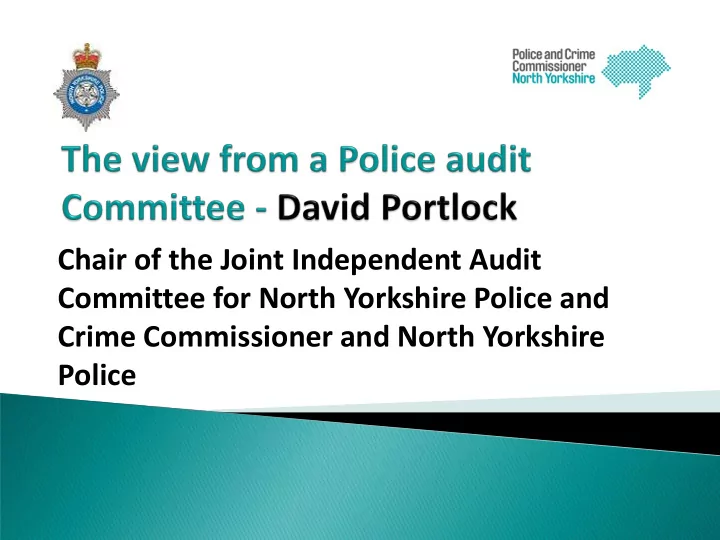

Chair of the Joint Independent Audit Committee for North Yorkshire Police and Crime Commissioner and North Yorkshire Police
NYP force area
NYP force area Total mileage of roads: approximately 9,000 km for North Yorkshire and 790km for the City of York Total population: approximately 600,000 for North Yorkshire and 200,000 City of York
Total personnel in NYP & OPCC as at 28 February 2014: Police Officers: 1,422 Special Constables: 160 Support Staff: 1,214 OPCC Private Office: 6 (to be 8) • Separate commissioning unit : 4
Organisational Meeting Structure Various Internal Meetings
Joint Independent Audit Committee: Three members Other attendees Four meetings per year Terms of Reference High level work programme Effectiveness to be reviewed in 2014
Experience to date: JIAC Membership Management structure change New Chief Constable appointed June 2013 Staff pressures 2012/13 Accounts and Annual Governance Statement
One to Ones: Police and Crime Commissioner Chief Constable Commissioner’s Chief Executive Officer Chief Finance Officers Head of Internal Audit Lead Director of External Audit
Challenges Recruiting more JIAC members Improving JIAC Members knowledge and understanding Commissioner’s Chief Finance Officer leaving in July 2014 Impact of funding cuts (more later)
Challenges continued Changing landscape: Collaborations, Partnerships, Commissioning Fraud seems to be more prevalent Transparency agenda v Data Protection Increasing political and public scrutiny When is a crime not a crime?
The impact of funding cuts: Reducing headcount (but not police officers) Must develop a ‘new’ way of doing things Risk Management must become ‘part of the way business is done’ – not tacked on at the end More risks will have to ‘be lived with’ Need for a culture change?
The impact of funding cuts: But be alert to the danger of Internal Audit becoming part of the decision making process – this is management's responsibility.
Audit Committees will need to: Improve their knowledge of what Commissioners and Forces do Deepen their understanding of the risks and the potential exposures Establish how risks are identified, prioritised and managed – and how frequently risks are reviewed Identify indirect risks and exposures through third parties as collaborations and partnerships increase
QUESTIONS Thank you
Recommend
More recommend